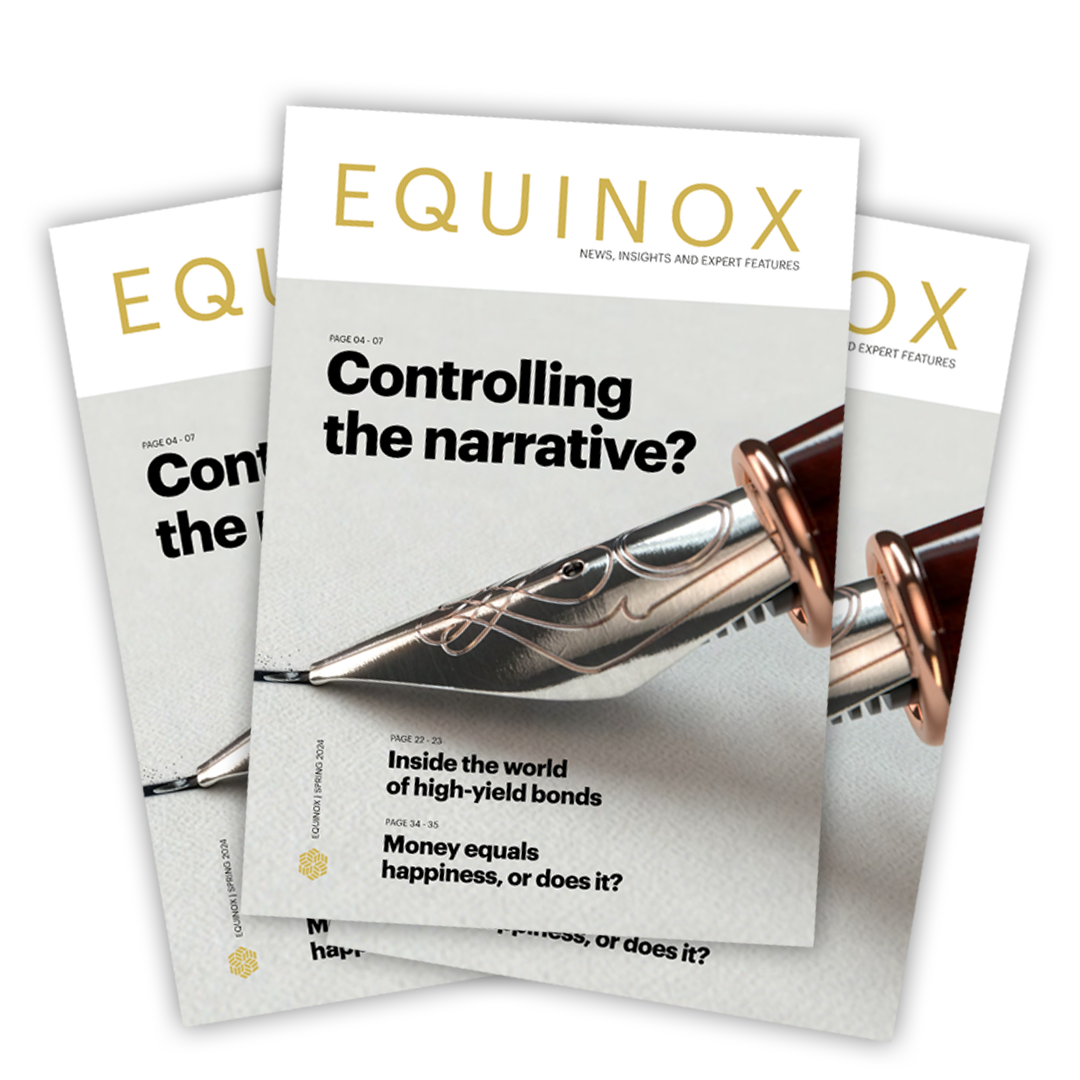Markets have been rocked in the past couple of weeks by concerns about two very different banks.
Silicon Valley Bank (SVB) is a relatively niche bank in the US, catering mainly to technology firms.
Meanwhile, Credit Suisse is what is known as a “Global Systemically Important Bank” (G-SIB) based in Switzerland. It has now been “merged” (forcibly taken over) into UBS, with help from the Swiss National Bank.
Both ran into difficulties for very different reasons, and this has knocked investor confidence. Stock markets fell sharply, although they have now rallied somewhat, and it is possible there may be a knock-on effect on the economy.
However, we are convinced this is a crisis of confidence and not a crisis in the banking system. Banks are safe, well capitalised and the issues experienced by a few institutions can be contained. This is not 2008.
The intention for this piece is to provide you with information on what is happening, and how it might affect both the economy and portfolios. We hope you find it reassuring.
Some clients just want to know the summary, whilst others want a lot of detail. We sent out a high-level summary of our thoughts last week, which can be found by clicking here.
This post is designed to bring all the information in one place, with optional “deep dives” for those who are interested in the detail. To see the deep dives, click the arrow next to the heading. To hide them, click the heading again.
If you have further questions after having read any of these pieces, please do not hesitate to get in touch.
What happened to SVB?
- SVB lost a lot of money on their portfolio of long-dated government-related bonds. These bonds are normally seen as very secure and if held to maturity, there would be no issues.
- However, because of rising interest rates, the market price of these bonds fell sharply last year.
- Depositors became worried and decided to take their money out, forcing SVB to sell bonds at a loss.
- Once a bank run starts, it is very difficult to stop and usually, the bank fails.
- SVB depositors have been bailed out by the US authorities. The assets of SVB UK have been bought by HSBC for a mere £1*.
For more detail, please click on ‘Silicon Valley Bank – deep dive’ to open/close this section.
Background*
- Silicon Valley Bank (SVB) was set up in the early 1980s by Bill Biggerstaff and Robert Medearis, over a game of poker, to provide banking services to the technology industry.
- SVB prized itself on building relationships with companies when they were in their infancy, providing services and a network to younger businesses that may not have been available from a traditional lender.
- From 2020 to 2022 the deposit base tripled as venture capital (VC) and high-tech startups boomed.
- At the end of 2022, SVB says that half of all US VC-backed technology and life science companies banked with them, along with 88% of the Forbes 2022 “Next Billion-Dollar Startups.”
- SVB was therefore very reliant on one subset of the global economy that was interconnected. However, as quickly as the money flooded in, it could flood out.
- At the end of 2022, SVB held $209bn in assets and $175bn in deposits (up from $49bn in 2018). As a result of this, it became the 16th largest bank in the US.
- With deposits flooding in, SVB invested into long-maturity assets such as government bonds and mortgage-backed securities.
- Amazingly, SVB had $10bn worth of interest rate swaps at the end of 2021 and none at the end of 2022. Interest rate swaps allow a bank to hedge against the risk of rising rates.
- Crucially, in 2018 regulatory changes meant that US banks with less than $250bn in assets did not have to disclose how much they had in high-quality, liquid assets to cover outflows in a period of stress.
The present*
- On 27 February, CEO and President of SVB, Greg Becker, sold shares worth $3.6m.
- On 8 March, SVB announced a loss of $1.8bn on the sale of $21bn in securities, as technology and life science companies had been drawing more heavily on deposits, leading SVB shares to decline by 60%.
- On 9 March, Venture Capitalist Peter Thiel (co-founder of PayPal amongst others) advised the firms he worked with to withdraw their cash. This went viral. Depositors panicked and tried to withdraw $42bn.
- 90% of depositors had more than $250,000 in their account – deposits below this level are insured by the government. This is an unusually high level of uninsured deposits. For example, 50% of Bank of America’s depositors have less than half of this amount.
- In the space of two days, SVB went from having one of the highest to the lowest credit ratings as the various agencies rapidly downgraded their assessment.
- As more and more depositors started withdrawing money there was a risk that the bank did not have enough liquidity to meet the withdrawal requests. On 10 March, the Federal Deposit Insurance Corporation (FDIC) stepped in and put the bank into receivership.
- On Sunday 12 March, the Federal Reserve announced the Bank Term Funding Program allowing loans of up to one year by pledging US Treasuries at par, increasing liquidity and eliminating an institution’s need to sell assets at distressed prices. Had this scheme been in place just four days earlier, SVB would have likely avoided the £1.8bn loss on its sale of securities.
- HSBC announced on Monday 13 March that it had bought the UK arm of SVB for £1 following just 5 hours of due diligence, securing the deposits of 3,000 customers worth £6.7bn.
- In essence, this means that all depositors with SVB were bailed out, but shareholders and bondholders will lose most (if not all) of their capital.
Individuals have reacted by pulling money from other small banks and reinvesting into larger more secure institutions. For example, as of 14 March, Bloomberg stated that the Bank of America has taken in $15bn of new deposits in just three days.
So, shares on small banks have fallen sharply. For example, another regional US bank called First Republic has seen its shares plummet, essentially because on the outside it looks similar to SVB.
Technically it should be boom time for big banks as they get to either win customers from smaller banks for nothing or pay nothing (ok, £1) as HSBC did for the whole business of SVB UK.
Ultimately, no bank on the planet can survive a run on its deposits. For more details on how a bank run starts, please click on ‘Bank run – deep dive’ to open/close this section.
Banks accept depositors’ money usually over short terms (5 hours to 5 years) and lend to individuals and businesses over longer terms, say 5 to 25 years.
So, excuse the oversimplification, but let’s say my bank has £150bn on deposit (available for instant withdrawals) and loans out £100bn (such as mortgages), then it has free cash of £50bn.
A rumour circulates on the internet that the bank is in financial difficulty and people start to withdraw cash. At this stage, it is irrational as no problem exists.
The next day, the news goes mainstream: “X Bank subject to withdrawals of £30bn in 2+ hours….” Now, if you read that, you would surely want to get into the queue for your money too.
It doesn’t take a maths whizz to work out that once withdrawals top £50bn there isn’t enough liquidity to meet them. . The bank may have the “assets” in theory, but they are long-dated loans and can’t just be called in to repay depositors instantly.
No bank can withstand a substantial run and even those with deposits below the £85k protection level (under the Financial Services Compensation Scheme) are still likely to want their money out.
Some banks now have a stamp that says: “Too big to fail.” Well, actually it says: “Global Systemically Important Bank” (G-SIB), which translates to “don’t worry if the bank fails, we will bail them out.” See the “G-SIB deep dive” below for more details.
Crucially, we believe this is very different to the financial crisis. Back then, banks were over-leveraged and taking far too much risk. Today, banks in general have far more capital and are taking far less risk with it.
What happened to Credit Suisse?
In short, a litany of scandals and examples of bad risk management over the past few years.
These are completely unrelated to issues with SVB. It is bad timing that further headlines about Credit Suisse appeared after confidence in the banking sector had already been rocked.
Whilst Credit Suisse was well capitalised, given the shaky confidence, depositors and investors started to move away in droves (a version of a bank run), placing the bank at risk of collapse.
In order to try to contain the situation, the Swiss authorities have “encouraged” a merger with UBS, another large Swiss bank.
The Swiss National Bank have provided funding to the new, larger bank to try to ensure confidence and liquidity. They have successfully managed to ensure there was no disorderly failure by a major Swiss Bank.
Shareholders in Credit Suisse received a mere fraction of what their shares were worth a few weeks ago as part of the merger/takeover. Some bondholders have seen their investments completely wiped out, which may knock the confidence of investors in other bank bonds.
However, depositors have again been reassured that their money remains secure.
For more details on the situation with Credit Suisse, please click on ‘Credit Suisse – deep dive’ to open/close this section.
Credit Suisse is (or, at least, was) a 167-year-old financial services company headquartered in Zurich, Switzerland.
The company has $1.3 trillion assets under management and in 2007, it was the eighth biggest publicly owned bank in the world. Just prior to the UBS deal, the bank’s value had dropped so much that it was only the 155th largest bank and the stock market was valuing it just above that of a small US regional bank, Webster Financial of Stamford, Connecticut. **
Why did this happen?*
Essentially due to poor risk-taking and poor management. The bank has been involved in a litany of large, bad deals over the last decade which individually did not bring the bank down but culminated in a long decline in its share price.
In brief, here is a summary of its misdeeds from just the last couple of years: –
- 2021: Credit Suisse lost $5.5bn due to its risky exposure to the US hedge fund Archegos Capital Management, which collapsed in early 2021. Credit Suisse said it took action by firing staff and promised to put risk management at the heart of its decision-making.
- 2021: Credit Suisse was forced to suspend $10bn of investor funds after the collapse of the supply-chain lender Greensill Capital, whose loans were packaged and sold to Credit Suisse clients. The bank is still trying to claw back money for clients.
- 2022: Regulators fined Credit Suisse £350m to settle the bank’s role in the Mozambique “tuna bonds” loan bribery scandal that resulted in the country’s currency losing a third of its value.
Recognising the growing risks, many customers voted with their feet, resulting in client outflows of around £98bn last year***. The loss of business was especially felt in Asian wealth management, which for many years had been an important source of profit growth.
Fast-forward to March of this year…
On Tuesday 14 March, Credit Suisse revealed that its auditor, PwC, had identified “material weaknesses” in its financial reporting controls, leading to the delay of the publication of its annual report.
The following day, Saudi National Bank (SNB) chair Ammar Alkhudairy said, “the answer is absolutely not” when asked if SNB would be open to providing capital to Credit Suisse. SNB had already bought a 10% stake in Credit Suisse last year.
His comments made headlines, although it is worth exploring what he actually said in an interview with Reuters:
“We cannot because we would go above 10%. It’s a regulatory issue.” He also added that SNB is happy with Credit Suisse’s transformation plan and suggested the bank was unlikely to need extra money.
Against the background of the Silicon Valley Bank and Signature Bank issues in the United States, investors were skittish about risks and sold Credit Suisse shares heavily until the stock was suspended by the Swiss Stock Exchange.
Bail out?
Credit Suisse is a Global Systemically Important Bank (G-SIB) (see the below section) which effectively means it is too important to the Swiss and global economy to be allowed to fail.
Initially, the Swiss financial regulator and central bank stepped in to confirm that Credit Suisse, “meets the higher capital and liquidity requirements applicable to systemically important banks” but also to, “provide liquidity to the bank if necessary.”
Credit Suisse then arranged to borrow up to £45bn from the central bank to buy back its bonds (which trade at a steep discount) to bolster its balance sheet.
However, even this was not enough to stop the rot. Over the following weekend, the Swiss authorities essentially forced a merger between Credit Suisse and UBS.
The SNB has also committed to providing as much liquidity as required to see the new bank through this current crisis of confidence. Much of Credit Suisse’s investment bank is likely to be wound down and other assets sold.
Shareholders in Credit Suisse will receive payment for their shares, but this is a fraction of what the shares were worth a few weeks ago.
Some bondholders will likely lose all their capital. This has surprised some in the market and means there is concern about other financial bonds. However, it does help to shore up the balance sheet of the newly enlarged UBS.
Depositors have been protected throughout and they will not lose any of their capital.
For more details about Global Systemically Important Banks (G-SIB), please click on ‘G-SIB – deep dive’ to open/close this section.
For more information about what it means to be a Global Systemically Important Bank, please click on ‘G-SIB – deep dive’ to open/close this section.
As the Credit Crisis in 2007-2008 unfolded, it became apparent that the banks and regulators were grossly ill-prepared for a banking crisis (for an excellent account of this malaise, we highly recommend the book, ‘Firefighting: The Financial Crisis and Its Lessons’; Penguin).
In the aftermath of the Crisis, the central bankers from the G20 major economies, collectively called the ‘Financial Stability Board (FSB)’, introduced the concept of the ‘Global Systemically Important Financial Institution’ (G-SIFIs) and for banks specifically, G-SIBs.
The idea was to identify the banks that are ‘too big to fail’ – where any failure of a bank may tip the dominoes to have a significant and wide impact on the financial system and even the broader economy.
To become a G-SIB, a bank needs to be very big and very connected. Every year the regulator will take a measure of the assets and liabilities of the bank and then stress-test the numbers to see how it may perform in different scenarios, such as a house price-led recession or sharply rising bad debts.
G-SIBs are subject to additional regulations, are generally held to higher capital requirements than their smaller peers and often have to hold more assets in proportion to their loans. Equilibrium only uses G-SIB banks for our defined returns investments because of this additional security.
As part of being a member of the G-SIB club, you must also submit to the regulator a bankruptcy resolution plan, or living will, as it is known.
A bank’s living will is meant to guide that company’s process of liquidation, should it fail. It details a contingency plan for how the bank will sell off assets or be liquidated in an ‘orderly’ way that does not generate aftershocks elsewhere in the financial system.
A typical bank ‘death’ scenario would entail the central bank stepping in to guarantee the customers’ deposits, taking full control of the business, selling parts off and winding the rest down.
The merger between Credit Suisse and UBS is the first time we have seen one of these action plans put into place. It remains to be seen if this will stop any further concerns or if there will be any knock-on effects. However, on the face of it, the process appears to have worked and a disorderly failure of Credit Suisse was avoided.
Implications for asset classes
Stock markets fell sharply over the past few weeks.
For example, the FTSE 100 which had been over 8,000 just a few weeks ago, dropped as low as 7,344 on 15 March. This morning (21 March) it had rallied somewhat to trade back over 7,500.****
Shares in banks have been particularly affected, as have the prices of some financial bonds.
On the flip side, government bond prices have gone up.
What might happen to the economy?
Given that confidence was fragile to begin with, we think there could be an impact on the global economy.
Firstly, banks will want to keep back more capital and may therefore tighten lending criteria / be more reluctant to lend.
Businesses may be more likely to hold off on new investments whilst they wait for things to settle down. Consumers may be less likely to spend for similar reasons.
Our base case is now back to being a likely slowdown / possible recession this year (in US, Europe, UK). However, this is still likely to be relatively mild, in our opinion, depending on what happens from here.
On the plus side, this means that the “sticky” service-led inflation may be less prevalent.
Central banks will likely want to pause rate hikes and may even be forced to cut if the economy does take a turn down.
Some estimates are that the “tightening” of credit conditions is equivalent to around 1.5% of rate hikes. If that’s correct, then there is less need to put up rates now and perhaps even a case for a short-term rate cut.
However, it is worth remembering that the economy has done better than expected so far in 2023.
What has happened to portfolios?
Whilst portfolios have dipped, the important thing in our minds is that they have not set fresh lows.
The table below shows how portfolios have performed since the lows of 12 October 2022. It then shows how much each fell from their recent peaks (6 February 2023), as well as the overall returns from 12 October 2022 to 15 March 2023.
| Equilibrium Portfolios | 12 Oct 2022 - 6 Feb 2023 (%) | 6 Feb 2023 - 15 Mar 2023 (%) | 12 Oct 2022 – 15 Mar 2023 (%) |
|---|---|---|---|
| Defensive | 5.81 | -2.33 | 3.35 |
| Cautious | 8.88 | -3.28 | 5.31 |
| Balanced | 10.15 | -3.91 | 5.84 |
| Adventurous | 11.09 | -5.50 | 4.98 |
| Global Equity | 11.37 | -7.18 | 3.37 |
(Source: FE Analytics)
What actions are Equilibrium taking?
We have completed numerous trades in all of our funds to reflect our latest thinking. As usual, we are focused on two main factors, risk and return.
To put it another way, we are making both “attacking” and “defensive” moves. For example:
- Attack: can we take advantage of what we hope will be short-term opportunities?
- Defence: what assets can we buy that might protect us if things get worse?
In summary, we have been topping up equity and other assets as they have fallen. At this stage, we have just gone back to our previous target weights – so if something was meant to be 3% of the portfolio and it dropped to 2.5%, we’ve topped back up to 3% – rather than going overweight. This is known as rebalancing.
In addition, we have made a number of switches in the non-equity parts of the portfolio to buy assets we think are more resilient to further falls, and have reduced exposure to financial bonds (including banks).
Generally, we’re comfortable with positioning as we’ve already been careful to balance risk of a downturn with recent positive economic momentum.
We believe that the “cost-of-living crisis” is nearly over and if inflation does drop to 2.8% later this year (as predicted by the Office for Budget Responsibility), if interest rates do stop rising and if public sector pay disputes get resolved, then perhaps the world can return to some sort of normality.
We hope you have found this interesting and reassuring. As always, if you have any comments, questions, or feedback, we would love to hear from you. If you’re a client you can reach us on 0161 486 2250 or by getting in touch with your usual Equilibrium contact. For all new enquiries please call 0161 383 3335.
*Bloomberg
**FT, Credit Suisse, the world’s 155th biggest bank, 15 March 2023
***CNBC, Credit Suisse posts massive annual loss as radical restructure gets underway
****Refinitiv Eikon / Equilibrium Investment Management
Past performance is for illustrative purposes only and cannot be guaranteed to apply in the future.
This blog is intended as an informative piece and should not be construed as advice.



